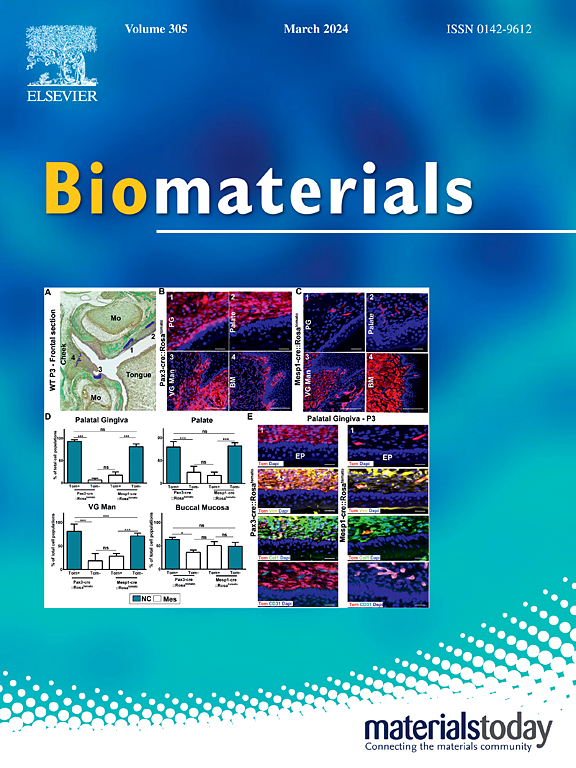Novel laser-textured grooves extended to the sidewall edges of CoCr surfaces for rapid and selective endothelialization following coronary artery stenting
IF 12.8
1区 医学
Q1 ENGINEERING, BIOMEDICAL
引用次数: 0
Abstract
The long-term performance of coronary stents is often compromised by delayed endothelialization and late thrombosis, particularly in drug-eluting stents (DES) that impair vascular healing. To address these challenges, we report a novel micro-hierarchical surface modification that integrates sidewall edge structuring into grid patterns on cobalt-chromium (CoCr) stents, enhancing endothelial cell (EC) interactions without compromising mechanical integrity. Laser fabrication was used to create microgrooves (5–30 μm) with extended sidewall edges, designed to promote rapid EC adhesion and proliferation. Comprehensive in vitro evaluations, including EC viability, adhesion, and platelet aggregation assays, demonstrated that stents with grid pattern and sidewall edge structuring on an already fabricated stent enhanced EC viability approximately six-fold compared to the non-patterned controls, reaching 2276 ± 220 cells/ml by day three of culture. The sidewall edges provided possible promising stable anchoring sites and gateway channels, improving EC attachment and selective alignment, while also substantially reducing platelet deposition in grooved regions. To ensure these surface modifications did not affect mechanical performance, comprehensive three-point bending and radial compression tests were conducted. No significant differences were observed compared to coronary stents, confirming that the micro-hierarchical texture with sidewall edges maintains essential mechanical properties. Together, these findings highlight the potential of sidewall edge-integrated grid patterns to accelerate endothelialization and reduce thrombogenic risks, offering a promising strategy for improving the design and long-term performance of next-generation coronary stents.
新型激光纹理凹槽延伸到CoCr表面的侧壁边缘,用于冠状动脉支架植入术后的快速和选择性内皮化
冠状动脉支架的长期性能经常受到延迟内皮化和晚期血栓形成的影响,特别是药物洗脱支架(DES)损害血管愈合。为了解决这些挑战,我们报告了一种新的微层次表面修饰,将侧壁边缘结构集成到钴铬(CoCr)支架的网格模式中,在不影响机械完整性的情况下增强内皮细胞(EC)的相互作用。采用激光制造技术制造具有扩展侧壁边缘的微凹槽(5-30 μm),旨在促进EC的快速粘附和增殖。综合体外评估,包括EC活力、黏附和血小板聚集分析,表明在已制成的支架上带有网格图案和侧壁边缘结构的支架与未图案的对照组相比,EC活力提高了约6倍,在培养的第三天达到2276±220个细胞/ml。侧壁边缘提供了稳定的锚定位点和通道,改善了EC的附着和选择性排列,同时也大大减少了凹槽区域的血小板沉积。为了确保这些表面修饰不会影响机械性能,进行了全面的三点弯曲和径向压缩试验。与冠状动脉支架相比,没有观察到显着差异,证实具有侧壁边缘的微观分层纹理保持了基本的机械性能。总之,这些发现强调了侧壁边缘集成网格模式加速内皮化和降低血栓形成风险的潜力,为改进下一代冠状动脉支架的设计和长期性能提供了有希望的策略。
本文章由计算机程序翻译,如有差异,请以英文原文为准。
求助全文
约1分钟内获得全文
求助全文
来源期刊

Biomaterials
工程技术-材料科学:生物材料
CiteScore
26.00
自引率
2.90%
发文量
565
审稿时长
46 days
期刊介绍:
Biomaterials is an international journal covering the science and clinical application of biomaterials. A biomaterial is now defined as a substance that has been engineered to take a form which, alone or as part of a complex system, is used to direct, by control of interactions with components of living systems, the course of any therapeutic or diagnostic procedure. It is the aim of the journal to provide a peer-reviewed forum for the publication of original papers and authoritative review and opinion papers dealing with the most important issues facing the use of biomaterials in clinical practice. The scope of the journal covers the wide range of physical, biological and chemical sciences that underpin the design of biomaterials and the clinical disciplines in which they are used. These sciences include polymer synthesis and characterization, drug and gene vector design, the biology of the host response, immunology and toxicology and self assembly at the nanoscale. Clinical applications include the therapies of medical technology and regenerative medicine in all clinical disciplines, and diagnostic systems that reply on innovative contrast and sensing agents. The journal is relevant to areas such as cancer diagnosis and therapy, implantable devices, drug delivery systems, gene vectors, bionanotechnology and tissue engineering.
 求助内容:
求助内容: 应助结果提醒方式:
应助结果提醒方式:


